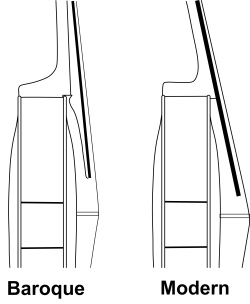The beloved cello that we know today as a relatively standardized instrument was not always so. Cellos can be traced back to Amati (1581-1632), Gaspar da Salo (1549-1609), and Paolo Maggini (1581-1632). Although still quite recognizable to a modern eye and ear, these proto-cellos were quite different in a number of ways; string material and tuning, neck length and angle, body dimensions, bridge dimensions, arching, bass-bar placement and dimensions, bow design, soundpost dimensions, and even the way in which players held the instrument and bow. For a brief primer, check out Emily Davidson's emilyplayscello Instagram reel.
The driving forces that propelled design changes, not surprisingly, were playability and sound projection. Simultaneously, while composers were demanding more virtuosity from cellists, performing venues were becoming larger as they shifted from churches to courts to concert halls. This compelled instrument makers to design instruments that allowed for greater agility and a bigger, more-projecting sound.To achieve a more powerful sound, the high-arched cellos of Amati and early-Stradivari turned into the lower-arched Stradivari "Forma B" inspired instruments that we still play today. In 1710, during Stradivari's golden period, he introduced the first Forma B, the "Gore-Booth" cello to the world. Dimensions: Length of the Back 75.6cm; Widest Width of the Upper Bout 34.2cm; Widest Width of the Lower Bout 43.8cm; Narrowest Width of the Middle Bout 22.9cm.
Many great cellos that were made in the Baroque era have since been altered to match modern sensibilities. To achieve a more playable instrument, the overall size was reduced, the neck angle increased, and endpins were added. Additionally, composers began to write music that required more range. Thus neck lengths, too, were increased. Each of the changes allowed a player to navigate around the instrument with greater freedom. Check out this pic, from Matthew Zeller's "Deconstructing the Andrea Amati 'King' Cello," to see how the midsection was removed along the center seam, and the bouts were reduced to cut down the Amati King Cello to modern dimensions.
For those measuring at home, here is a list of the original dimensions versus cut-down dimensions: Length of the Back 78.2cm cut to 75.5cm; Widest Width of the Upper Bout 39.1cm cut to 34.3xm; Widest Width of the Lower Bout 48.9cm cut to 44.2cm; and Narrowest Width of the Middle Bout 27.7cm cut to 23.6cm.
While the instrument itself was undergoing dramatic transformations, so too, was the way in which players held the bow. One will see examples of cellists holding the bow underhand (some bassists still play with "German" bows), overhand above frog (modern hold), and overhand higher up the stick.
Are you a cellist or interested in becoming one? Take a look at our Fine Cellos modeled after Stradivari's instruments.
Vanscheeuwijck, Marc (1996) "The Baroque Cello and Its Performance," Performance Practice Review: Vol. 9: No. 1, Article 7. DOI: 10.5642/perfpr.199609.01.07
Available at: https://scholarship.claremont.edu/ppr/vol9/iss1/7





